Follow the General Secretary to See China | For a long time, grasp the "key little things" and practice the new fashion of low-carbon life
In August, the high temperature, humidity and rain in Shanghai for several days did not affect the cleanliness of the front of the domestic garbage wing of Ruihong New Town Phase II in Anqiu Residential Area, Jiaxing Road Street, Hongkou District. It was kept neat and tidy, and there were few mosquitoes and flies.
一大早,记者见到居民区书记雷国兴的时候,她正在跟居委干部和志愿者们开会,讨论小区里垃圾回收精品示范点位的推进工作。“现在正好有这个机会,我们一定要抓住,并且要做好,居民们都期盼着呢!”
从2018年11月习近平总书记来到这里考察,到今年5月底,收到总书记勉励大家工作的回信,近5年时间,雷国兴历经3个居民区党总支书记的岗位,也见证了上海垃圾分类从“不愿分、不会分”到“主动分、智慧分”的过程。“总书记的回信,是压力也是动力,给我们提出了新的更高要求。”
纵观上海,在“人民城市”重要理念的践行过程中,从垃圾分类新时尚到绿色低碳新生活,从社会基层治理到生态文明建设,人民群众的生活场景愈加智能,也愈发丰富多彩。
从新时尚到好习惯,紧盯“关键小事”不放松
时间回溯到2018年11月6日,习近平走进上海市虹口区市民驿站嘉兴路街道第一分站。几位年轻人正在交流社区垃圾分类推广的做法,一位小伙子说,参加公益活动对年轻人来说都是新时尚。习近平表示,垃圾分类工作就是新时尚。我关注着这件事,希望上海抓实办好。
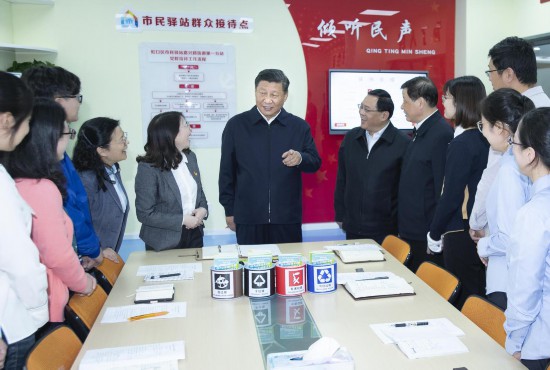
2018年11月6日上午,习近平来到虹口区市民驿站嘉兴路街道第一分站。几位年轻党员在交流社区垃圾分类推广的做法。 新华社记者 李涛摄
这次给总书记写信的执笔人、时任市民驿站嘉兴路街道第一分站党建服务站站长的雷国兴,也在现场聆听了总书记的指示。雷国兴说:“垃圾分类给老百姓带来了环境上的改变,邻里关系也更加和谐,这为基层社区治理提供了一个很好的支点。”
垃圾分类工作在上海如火如荼推进开来。2019年1月,《上海市生活垃圾管理条例》经上海市人大表决通过,于当年7月1日起正式施行。上海也因此成为全国最早全面开展垃圾分类的城市之一。
4年时间倏忽而过,垃圾分类推行效果如何?
吃过晚饭,约莫晚上7点钟左右,在瑞虹新城二期小区生活垃圾投放点,居民吴青葆动作娴熟地把干湿垃圾分类投放进不同的垃圾桶。“养成习惯了,每天吃好晚饭,就把当天的厨余垃圾连同干垃圾统统处理掉。”
从“新时尚”到“好习惯”,可不是件容易的事儿!
去年年初,雷国兴调任安丘居民区党总支书记后,她发现,辖区约40%的住户是租户,房屋换手率高,“新来的租户对社区情况、垃圾投放点、投放规则都不太了解,经常在垃圾房旁边看到落地垃圾。”
雷国兴与志愿者们商量后,制作出一份“迎新手册”。“住进小区的居民,都会拿到这本手册,里面收录了各类便民服务信息,包括怎么扔垃圾,怎么停车,居委会、物业、便民食堂在哪里等等,给大家一种宾至如归的感觉。”
“习近平总书记在回信中说‘得知经过这几年的宣传推动,垃圾分类在你们那里取得新的成效,居民文明程度提高了,社区环境更美了,我很欣慰。’”写信人之一、瑞一居民区党总支书记华磊说,“读到这里,我特别激动。”
“一开始,大家连什么是干垃圾、湿垃圾都分不清楚。”垃圾分类推行之初,华磊组织志愿者挨家挨户分发垃圾分类宣传画册、冰箱贴等,还通过开展垃圾分类趣味竞赛、拾荒慢跑等活动,提高居民垃圾分类的意识和参与度。几年坚持下来,成效显著,老百姓的参与度越来越高。
"In Jiaxing Road Street, Hongkou District, the rate of garbage sorting in the community has reached 100%, and the accuracy of delivery has reached 98%." According to the relevant person in charge of Jiaxing Road Street, the street has formulated five working mechanisms including "three-level management, classified inspection, supervision and rectification, analysis and evaluation, and volunteer training", including the assessment of garbage classification work neighborhood committees and the inspection mechanism of domestic garbage classification. More than 100 batches of teams from all over the country came to study and study.
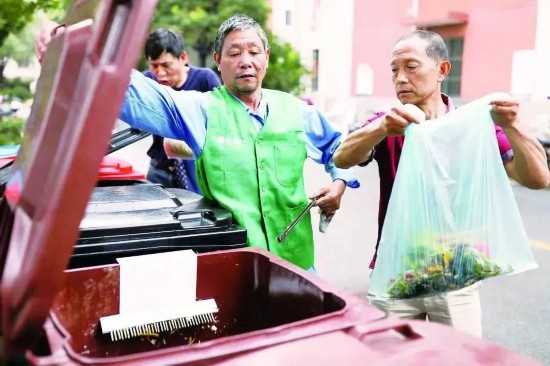
Residents are putting garbage in an orderly way. Photo courtesy of Hongkou District Rong Media Center
In the past four years, Shanghai has been keeping an eye on "key little things", and garbage sorting has brought real changes to the community appearance and ecological environment. A set of data recently released by the Shanghai Municipal Bureau of Greening and Appearance can be seen:
The actual effect of domestic waste sorting remained stable, the amount of wet waste separated was basically stable at about 35% of the total dry and wet waste, and the average daily recovery amount of recyclable materials reached 7284 tons; The compliance rate of residential area classification has increased from 15% before the implementation of Shanghai Municipal Domestic Waste Management Regulations to over 95% at present, and the compliance rate of unit classification has reached 95%. The terminal resource treatment capacity of domestic waste has been steadily improved. The total capacity of incineration and wet waste resource utilization in the city has exceeded 36,000 tons/day, and the recycling rate of domestic waste has reached 42%, achieving "zero landfill" of primary domestic waste.
From "throwing into a basket" to "subdividing into four buckets", from prescribed actions to conscious actions, from new fashions to good habits, garbage sorting has become a microcosm of Shanghai’s efforts to promote grassroots governance with "embroidery kung fu" and a vivid embodiment of megacities’ green development.
The concept of green and low carbon is integrated into every detail of urban governance.
Nowadays, in the Ruiyi residential area where Hualei is located, the newly renovated garbage house is equipped with photovoltaic solar panels, and the power generation can be directly used by the lights on the ceiling of the garbage house, which is low-carbon and energy-saving!
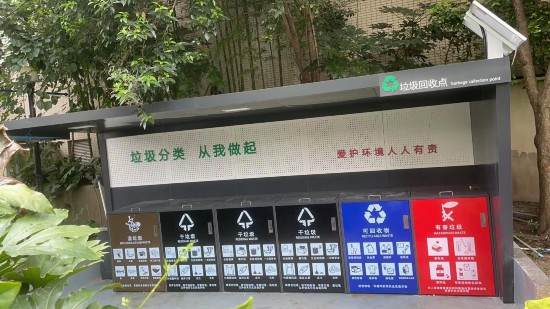
The garbage room is equipped with photovoltaic solar panels. People’s Daily reporter Tang Xiaoli photo
In the second phase of Ruihong, the demonstration project of garbage recycling boutique is also in progress. "Now the residents’ enthusiasm for garbage sorting is even higher, and suggestions should be made to do a better job in garbage sorting in the community and practice the concept of low-carbon environmental protection." Talking about the demonstration site project, Lei Guoxing said that some young people in the community suggested that transforming the community into a zero-carbon community and upgrading the garbage wing to a smarter and smarter version should not only be "tall" but also "grounded".
Therefore, nine young volunteers with professional design background in the community volunteered to participate in the renovation of the design smart garbage wing. "In another month, this 24-hour smart garbage wing, which integrates low-carbon and environmental protection elements such as code scanning delivery, parent-child sink, solar panel, exhaust fan and fine classification delivery area, will be completed."
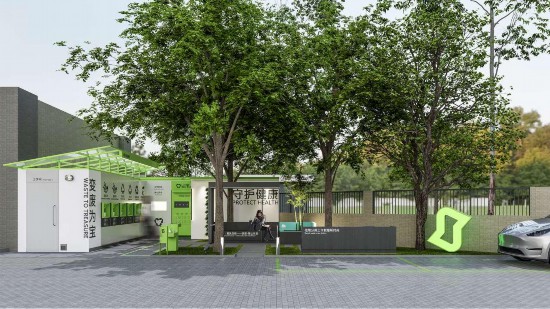
Ruihong phase II intelligent garbage wing design. Photo courtesy of Jiaxing Road Street, Hongkou District
As Lei Guoxing said, after four years of comprehensive implementation, in Shanghai, garbage classification is no longer a simple literal meaning, and it is moving towards a deeper low-carbon environmental protection new life.
The concept of green and low carbon goes first, and it is indispensable to empower smart technology.
Since October 2019, Jiaxing Road Street has cooperated with third-party enterprises to promote the unified and intelligent transformation of "technology+management" for garbage classification, installed intelligent sensor cameras and voice reminder systems for the classified delivery points in the jurisdiction, and developed application software to create a "smart brain" for garbage classification.
Nowadays, in Jiaxing Road Street, through the functions of remote supervision, real-time intercom, voice reminder and online tracing of the delivery behavior App, the delivery of garbage compartments in the community is inspected and monitored in real time, so that timely discovery, rectification and timely response can be achieved, and the concerns of residents can be solved.
Of course, not only garbage sorting, but also examples of technology enabling green and low-carbon life abound in Shanghai.
In recent years, Putuo District of Shanghai has been actively carrying out the action of creating distinctive green communities through the "One Street, One Town, One Plan", and green homes with leisure, strollability and temperature have gradually emerged around the citizens.
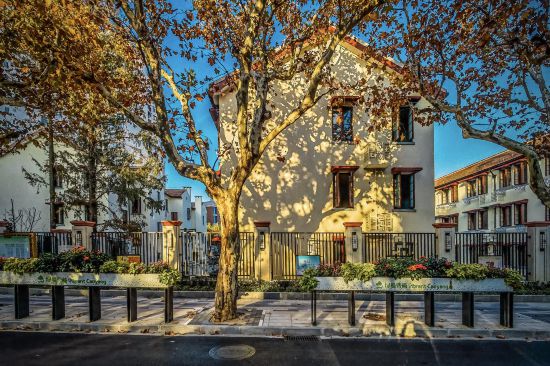
The first workers’ village in New China is now reborn. Photo courtesy of Cao Yang Xincun Street, Putuo District
Yuanyuan Community, known as Cao Yang Village, was founded in 1951 and is the first worker’s village in New China. Now it has become a model case of green community.
Beautiful roads such as Huaxi Road, Fengqiao Road and Tangpu Road have been built in and around Yuanyuan Community. All roads are made of environmentally-friendly permeable bricks, which are not only beautiful and practical, but also can better store water sources and achieve the effect of regulating local temperature and humidity and optimizing air quality. Tree-lined roads combined with Cao Yang’s unique river system around the river form a comfortable and livable community ecological environment.
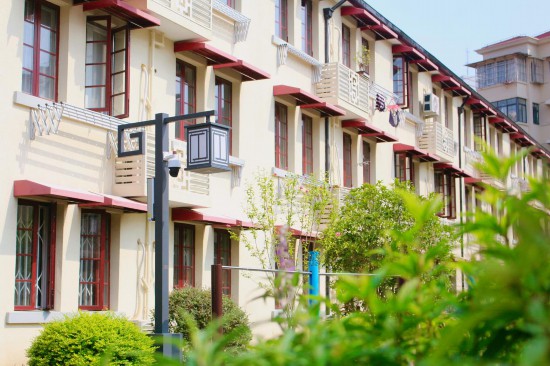
5G artificial intelligence lamppost installed in Yuanyuan community. Photo courtesy of Cao Yang Xincun Street, Putuo District
It is worth mentioning that Yuanyuan community also has a "smart model". In addition to the new energy charging piles, the community has also installed 5G artificial intelligence light poles, which can simultaneously realize smart lighting, environmental monitoring, LED advertising screen, video monitoring and other functions. The outdoor intelligent "public living room" has a unique intelligent ceiling and roller blinds, which can also be automatically controlled according to the weather conditions, and it is full of science and technology.
This old community, which has existed for 72 years and bears a strong historical memory, has been rejuvenated.
In the governance of Shanghai, a super-large city, taking green and low carbon as a necessary option into every work detail is an improvement of governance concept and governance efficiency for the government management level. For the citizens, the advantages of green and low carbon and ecological civilization are even more tangible and deeply rooted in the hearts of the people.